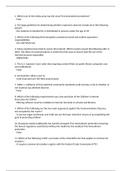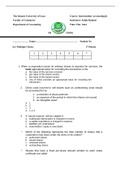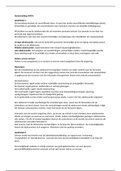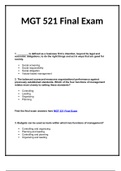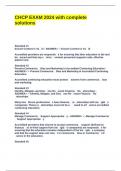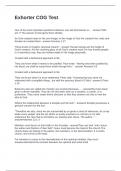strategies (MKB-8)
Handbook
Risk assessment and threat analysis
2021-2022
Department of Psychology
University of Groningen
Course lecturer: Dr. Mirjam Frey
Version: September 2021
1
,Table of content
Chapter 1. General introduction to risk assessment in forensic settings............................
Artikel 1 Kivisto, A. J. (2016). Violence risk assessment and management in
outpatient clinical practice. Journal of Clinical Psychology, 72(4), 329-349................
Artikel 2: Lewis, G. & Doyle, M. (2009). Risk Formulation: What are we
doing and why? 7 International Journal of Forensic Mental Health, 8, 286–
292..................................................................................................................................
This article illustrates further the process of risk formulation and why we do
it. Formulation is part of risk assessment to understand the process and what
needs to be considered when completing a risk assessment..........................................
Artikel 3 Fazel, S., Singh, J. P., Doll, H., & Grann, M. (2012). Use of risk
assessment 12 instruments to predict violence and antisocial behaviour in 73
samples involving 24 827 people: Systematic review and meta-analysis. BMJ,
345.e4692.....................................................................................................................
Guy, L. S., Packer, I. K., & Warnken, W. (2012). Assessing risk of violence
using 14 structured professional judgment guidelines. Journal of Forensic
Psychology Practice, 12(3), 270–283...........................................................................
This journal provides an overview of the SPJ approach and a review of the
empirical literature which supports this model. As the HCR-20 uses a SPJ
approach it is important to understand this approach along with its strengths
and limitations..............................................................................................................
Chapter 2. Risk assessment to be used with adult violent offenders: Historical
Clinical Risk Assessment- 20 (HCR20)..........................................................................
Chapter 3. Risk Assessment with Violent Youths (12- 18 years of age):
Structured Assessment for Violence Risk in Youth (SAVRY).......................................
Chapter 4. Risk assessment to be used with Domestic violent offenders: Spousal
Assault Risk Assessment.................................................................................................
(SARA)............................................................................................................................
Arikel 1: Helmus, L., & Bourgon, G. (2011). Taking stock of 15 years of
research on the Spousal Assault Risk Assessment Guide (SARA): A critical
review. International Journal of Forensic Mental Health, 10, 64-75..........................
Artikel 2: Hanson, R.K., & Wallace-Capretta, S. (2004). Predictors of
criminal recidivism among male batterers. Psychology, Crime and Law, 10,
413-427.........................................................................................................................
2
,Chapter 5. Risk assessment in sexual offenders: STATIC99R, STABLE-2007,
and ACUTE-2007............................................................................................................
Chapter 6. Risk assessment used in suspected and proven child maltreatment:
California SDM Hotline Tools and California SDM Family Risk Assessment..............
3
, Chapter 1. General introduction to risk
assessment in forensic settings
Artikel 1 Kivisto, A. J. (2016). Violence risk assessment and management in
outpatient clinical practice. Journal of Clinical Psychology, 72(4), 329-349
This article will help you to understand about violent risk assessment and
why we do it? It will also help you to understand the difference
between static and dynamic risk factors and the importance of risk
management plans, especially for people who are released from forensic
services and who may be at risk of committing further violent crimes.
Key differences in the therapeutic vs forensic practice of violence risk assessment and
management:
1. Identifiable victims: Legal considerations related to the clinical practice of evaluating
patients’ risk for violence generally requires an “identifiable victim,” something
relatively atypical in forensic risk assessment. Given this, actions that compromise
dangerous patients’ confidentiality almost always require relatively unambiguous
evidence of either an explicit threat targeting a specific person or actual violence.
Clinical reality, however, is indeed ambiguous, and it is the exception rather than the
rule that a clearly identifiable victim is named, even by those threatening homicidal
violence. Because most standardized risk assessment measures are designed to evaluate
an individual’s general level of risk for violence, relative to an appropriate normative
comparison sample and against any target, the relevance of these instruments to the
specific requirements for targeted violence in outpatient treatment settings warrants
consideration.
2. Imminent vs time unlimited risk: Risk assessment by treating clinicians typically
involves a circumscribed, albeit ill-defined, time frame for violence risk consideration.
The window of time typically considered in forensic risk assessment, by contrast, is
relatively open-ended.
3. The role of mental illness: The presence of mental illness typically carries less legal
relevance to the risk management responses of outpatient treatment providers. If
treatment providers foresee risk, they have a legal duty to protect regardless of whether
their patient meets diagnostic criteria for a mental disorder. In contrast, forensic risk
assessment often requires both dangerousness and mental illness to permit commitment
as a risk management response.
4. Nature of the professional relationship: So long as the potentially dangerous patient
does not trigger a duty to protect or consent to breaching confidentiality, treatment
providers can be limited in their ability to involve third parties to mitigate risk. In
4


